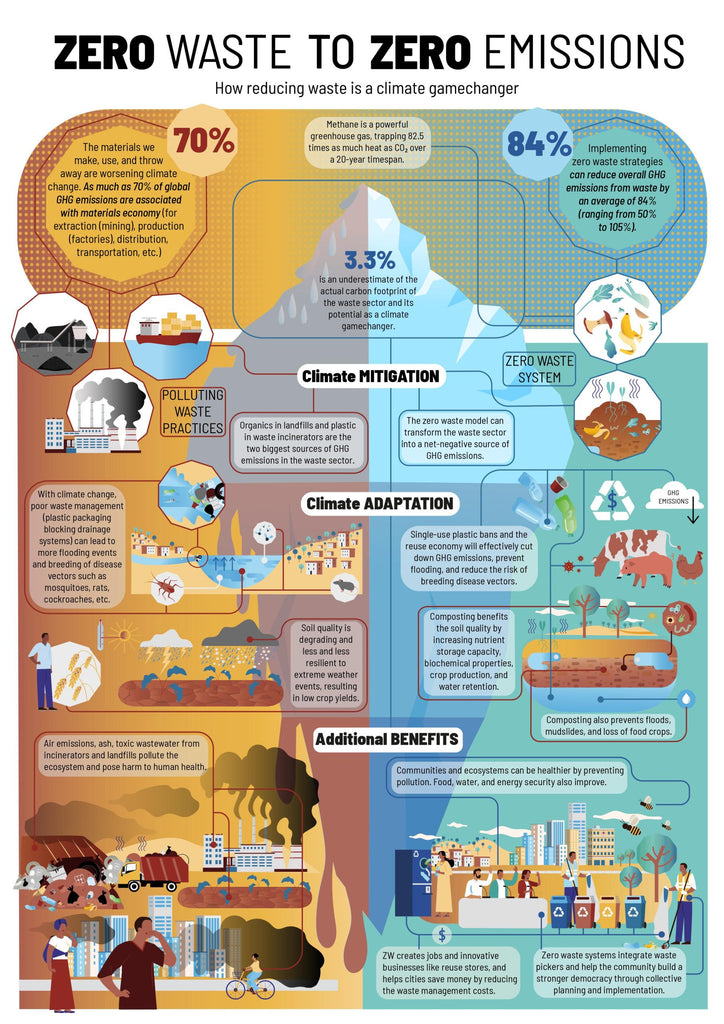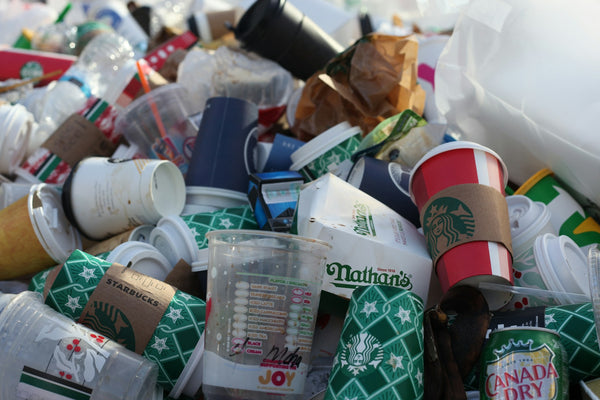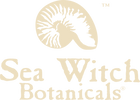Humans dump a whopping 2.12 billion tons of waste into our land, air, and waterways each year—a major environmental issue the zero waste movement is striving to address. Already exceeding our planet’s biocapacity by 170%, we currently require 1.7 Earths to continue living the way we do now.
With up to 70% of global greenhouse gas emissions coming from the production and distribution of materials that ultimately become waste (known as the materials economy), it’s clear that something needs to change. It’s imperative that we reduce our collective waste, but is generally living as waste-free as possible truly a feasible solution?
The answer is: It’s complicated. The zero waste movement is well-intentioned and clearly needed, but may take some rethinking in order to be effective. If we are truly to reduce or eliminate our global waste, we need to implement significant cultural and systemic changes that hold us all accountable: individuals, communities, governments, manufacturers, and corporations alike.
In this article, we’ll explore the benefits and pitfalls of the zero waste movement, the sources of global waste and barriers to waste-free living, and the solutions we all can use to collaboratively create a sustainable, waste-conscious relationship with our planet.
Photo by Naja Bertolt Jensen on Unsplash.
What Is the Zero Waste Movement?

Photo by Sam Harrons on Unsplash.
It’s more than just an out-of-reach, Instagramable lifestyle trend: The zero waste movement is an initiative to completely eliminate global waste by “encouraging a more circular approach to the way we use resources,” writes ZeroWaste.com. The Zero Waste International Alliance defines zero waste as:
“The conservation of all resources by means of responsible production, consumption, reuse, and recovery of all products, packaging, and materials without burning and with no discharges to land, water, or air that threaten the environment or human health.”
As we’ll discuss later, our present materials economy follows a five-stage linear path, from the extraction of resources to the disposal of products, leaving little room for materials to be reused or responsibly reincorporated into the environment. This system creates the conditions for an exponential accumulation of waste products like single-use plastics in every corner of our planet.
The idea that a material can only have one life is uniquely human: Every substance in nature is part of a closed-loop cycle, wherein even waste has nutrients to offer the wider ecosystem and can be infinitely reused.
This is the standard the zero waste movement seeks to restore. Through collaborative action and community organizing, ZeroWaste.com writes that “the goal of zero waste is to push economies towards the target of sending no waste to landfill, incinerators, and the ocean.”
However, due to a lack of widespread visibility or cultural awareness about our global waste crisis, the zero waste movement tends to get diluted through social media. With a lack of educational resources or emphasis on the need for systemic change, the notion of living a waste-free lifestyle becomes a burden for the consumer to bear. Especially with viral challenges like packing an entire year’s worth of trash into a single mason jar, the zero waste movement is all too easily presented as just another exhausting, unrealistic trend of climate activism that is inaccessible to many and ineffective in the long run.
This conceptualization of zero waste seems like it requires global participation to gain any traction because it places all the responsibility for conscientious waste management in the hands of the consumer. In actuality, when it comes to materials like single-use plastics, 60% of emissions occur before they reach the consumer’s hands.
The zero waste movement most folks are familiar with is one that focuses only on what happens to materials after being purchased. This is an important piece of the puzzle, but it does not account for the full picture. In order for these individual actions to have any meaningful impact, we need to turn our attention to stopping the crisis at its source: production.
Where Does Global Waste Come From?

Garbage in the Himalayas. Photo by Sylwia Bartyzel on Unsplash.
Plastic waste is one of the primary focuses of the zero waste movement, and for good reason: According to the UN, humans produce around 400,000,000 tons of plastic waste each year. “That’s roughly the weight of all humans on the planet,” writes The Ocean Cleanup, “and plastic production is projected to keep going up,” potentially reaching over 1 billion tons per year by 2050. What’s worse: our planet is already choking on a cumulative 7 billion tons of plastic waste from production over the past decades.
Around 50% of all plastics produced today are considered single-use plastics. These plastics cannot be recycled and are unlikely to be reused, so they are discarded once their purpose has been fulfilled. The UN writes that “some 98% of single-use plastic products are produced from fossil fuel, or ‘virgin’ feedstock.” That means nonrenewable resources like crude oil or natural gas were extracted from the Earth specifically to make these made-to-throw-away products: an exponentially unsustainable pathway for production.
A domineering force driving plastic production is the need for packaging, which accounts for around 36% of all plastics created. Think: plastic bags, water bottles, disposable cutlery, snack bags, ice cream tubs, packaging film, deodorant containers, lip balm tubes, shampoo and perfume bottles, home cleaning products, dish soap bottles…the list goes on and on.
All this plastic is taking over our environment. Those 400,000,000 tons of plastic waste amass in landfills, litter ecosystems, strangle wildlife, pollute our waterways and drinking supply, or get sent to incinerators to be burned. On a daily basis, we are consuming and breathing plastic, whether we know it or not.

Infographic from the EPA's article From Farm to Kitchen: The Environmental Impacts of U.S. Food Waste
Another important focus for the zero waste movement is food waste. According to the EPA, food waste from the US alone generates at least 170 million tons of CO2 emissions each year, equivalent to the annual emissions of 42 coal-powered plants. Even worse, food rotting in landfills is estimated to account for more than 14% of US emissions of methane, a greenhouse gas even more potent and harmful than CO2. The easiest and most effective solution to this issue is to integrate composting into our waste management strategies. However, due to systemic barriers, this is presently not an accessible option for everyone.
This horrifying data is a lot to contend with, especially when considering that, as consumers, there’s only so much we can do to reduce our global waste. While it is definitely valuable to be composting our foods and opting for more waste-conscious products, these individual actions do not get to the meat of the issue. Simply put, we need to stop producing plastic. Yet, because we operate within inherently wasteful economic systems, doing so is proving to be a much greater challenge than you’d think.
Systemic Barriers to Zero Waste

Infographic from the Global Alliance for Incinerator Alternatives (GAIA)'s 2022 report, Zero Waste to Zero Emissions.
If our economic systems are structured to generate waste endlessly, then consumer habits are not the most important piece of the global waste puzzle—especially considering that as few as twenty companies produce more than half the world’s single-use plastic waste (with ExxonMobil the world’s worst culprit, representing 5.9 million tons of single-use plastic production per year). Going zero waste needs to mean more than dealing with plastic after it’s been used: It needs to tackle plastic before it gets made.
The primary barrier we encounter in the zero waste movement is our materials economy. As previously mentioned, our materials economy presently follows a linear path that can be broken down into the following five stages: extraction (mining, logging, or other natural resource exploitation); production (mixing natural resources with frequently toxic chemicals in factories); distribution (transporting and selling products at the lowest prices possible); consumption (purchasing and using distributed goods); and, finally, disposal (discarding, dumping, or incinerating used products).
Herein lies the reason for all these single-use products. Our economy favors products that are designed to have only one life cycle because, under this linear system, there is far more room for profitability that way. Because corporations rely on this system to survive, consumers have to, as well.
Unfortunately, this system is not only federally subsidized, but also weaponized against communities of color. A recent report by the Environmental Integrity Project found that “billions of taxpayer dollars in the US are helping to pay for dangerous, and often illegal, air pollution from a rapidly-growing plastics industry that disproportionately threatens Black and Latino communities that live beside plastic manufacturing plants.” This is an important reminder that wild ecosystems are not the only victims of our wasteful systems of production and consumption—our linear economy has very real ramifications on public health and human quality of life, too. It should not be acceptable to use environmental racism to deflect these impacts.
The extraction of resources and production of materials in factories is already a major pollutant (again, this accounts for 60% of plastic emissions), but the impact of these industries is compounded by the lack of effective waste management.

A heaping pile of used coffee cups off the street in New York. Photo called "Trash-To-Go" because the cups are used only a few minutes till they are trash. By Jas Min on Unsplash.
Did you know that less than 10% of all plastics we’ve made have ever been recycled? Recycling in general is energy-intensive and expensive, and plastic degrades during the process, which makes the material unlikely to be reused more than once or twice.
Even if we as individuals diligently recycle our used products, the disheartening truth is that our recyclable waste is not responsibly managed. Only 5% of plastic waste in the US is properly recycled. In some cases, it only takes one piece of non-recyclable trash to send a whole bin of recyclables to the landfill; even if the recyclables do make it to recycling centers, they face a slew of other pollutive barriers to being successfully reused.
With the subsidized availability of cheaper fossil fuels, it makes a lot more sense from a market standpoint to just keep making new plastics.
In fact, the oil and gas industry has actually invested millions in selling the myth of recycling. “If the public thinks that recycling is working, then they are not going to be as concerned about the environment,” says Larry Thomas, former president of the Plastics Industry Association.
It’s easy (albeit unfair) for corporations to shirk the responsibility for global waste onto the consumer, and living a zero waste lifestyle seems like an appropriate solution to the problem from the consumer’s side. Yet, given the ubiquity of the material and especially its cheap economic value, boycotting plastic is expensive. This is a problem we encounter everywhere in the environmental movement: Sustainable choices just cost more, and the average person simply cannot afford to not buy plastic.
Going zero waste should not be a class issue, nor should the reduction of waste depend entirely upon consumer choices. Systemic changes are necessary to meaningfully address our global waste crisis. We must be able to hold industries accountable for their environmental violations while incentivizing a circular materials economy that offers a much wider range of accessible alternatives to plastic products.
How You Can Move Toward Zero Waste

Infographic from the Global Alliance for Incinerator Alternatives (GAIA)'s 2022 report, Zero Waste to Zero Emissions.
A zero waste lifestyle is environmentally ideal, yet virtually impossible for the average consumer to achieve by individual action alone. Realistically, we won’t ever be 100% waste-free. However, through collaborative and persistent efforts toward our zero waste goal, we can bring about the systemic changes needed to significantly transform our footprint of waste on our planet. Here are a few actions you can take today to contribute to the movement toward zero waste.
Have any tips and tricks for waste-conscious living? We’d love to hear from you in the comments below!






